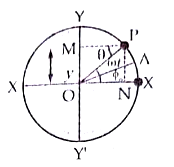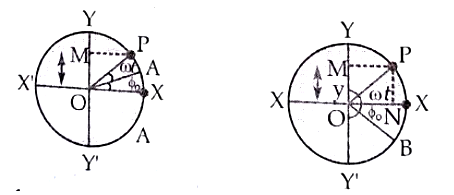Displacement: Consider a reference particle moving on a circle of reference of radius a with uniform angular velocity ω. Let the particle start from the point X and trace angular distance θ radian in time t as it reaches the point P.
Therefore, ω = \(\frac{\theta}{t}\) or θ = ωt.
Let the projection of the particle P on diameter YOY’ be at M. Then OM = y is the displacement in S.H.M. at time t.
In ∆OPM, sin θ = \(\frac{OM}{OP}\) = \(\frac{y}{a}\)
or y = a sin θ = a sin ωt …(i)
Important notes.
(i) If projection of P is taken on diameter XOX’, then point N will be executing S.H.M. Here, ON = x = Displacement in S.H.M. at time t.

In ∆ONP, cos θ = \(\frac{ON}{OP}\)
or x = a cos θ = a cos ωt …(ii)
(ii) If A is the starting position of the particle of reference such that ∠AOX = ϕ0 and ∠XOP = ωt.
Θ = ∠XOA = ωt − ϕ0
Here (−) ϕ0 is called the initial phase or epoch of S.H.M.

(iii) If B is the starting position of the particle of reference such that
∠BOX = ϕ0
∠BOP = ωt.
Θ = ∠XOP = ωt + ϕ0
From equation (i) y = a sin(ωt + φ0)
From equation (ii) x = a cos(ωt + ϕ0 )
Here (+) ϕ0 is called initial phase or epoch of S.H.M.